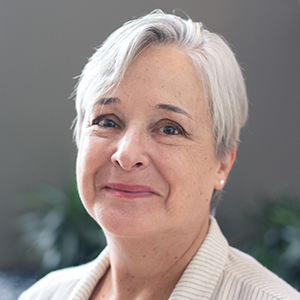Behind the scenes of the annual meeting
No matter how much planning you do, sometimes Wolverine crashes the party.
In her 14 years of organizing the society’s annual meeting, American Society for Biochemistry and Molecular Biology meetings manager Joan Geiling has handled a lot of surprises, but even she was unprepared when the Marvel Comics character showed up screaming among more than 200 distinguished guests at the Journal of Biological Chemistry editorial board dinner in Chicago, complete with blood, claws and torn shirt.
The disruptive figure didn’t come out of nowhere. It turned out that the Chicago Comic and Entertainment Expo, or C2E2, a pop culture event similar to Comic Con, was booked in McCormick Place on the same April weekend as the 2017 Experimental Biology annual meeting of six scientific societies, including the ASBMB.
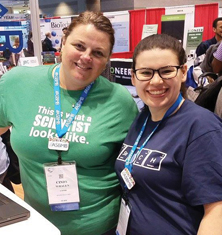 Cindy Whalen (left), membership coordinator, and Joanna Mooney, marketing coordinator, were
Cindy Whalen (left), membership coordinator, and Joanna Mooney, marketing coordinator, wereamong the 20 ASBMB staffers
who worked at the 2017 annual
meeting in Chicago. Courtesy of cindy whalen
The ASBMB staff faced the odd interruption with aplomb. Senior Director of Publications Nancy Rodnan escorted the noisy interloper from the room, and the serious business of science continued.
Even with months of meticulous planning, almost every meeting includes at least one surprise. “Every year, you think you’ve handled every possible curveball,” Geiling said with a laugh.
Brainstorming
All that planning begins about 18 months before the event, she said, when “the little seed is formed — who will organize, what the topics will be.”
The choice of each year’s two co-chairs is crucial, according to both Geiling and Dan Raben, a biochemist at Johns Hopkins Medicine and chair of the ASBMB meetings committee, who acts as overseer to the process. The co-chairs are tasked with developing their dream team of presenters, Geiling said, and they need to take into account the meeting’s scope.
“The major challenge for the co-chairs is to get scientific balance in the meeting,” Raben said, “to get great scientific presentations at the meeting, highlight and discuss emerging scientific issues and try to think of something new we can do … We try to give them as much freedom as possible.” He stressed the importance of striking a balance in geography, gender and race, as well, adding, “The science has to rule it all, but you can meld it with everything else.”
With the 2017 meeting, much was new. For more than a decade, the program had revolved around themes that corresponded to the ASBMB disciplines. But there was a downside in trying to extend that to every day of the conference, Raben said, and sometimes sessions were not well-attended.
Organizers decided they wanted to go with what’s hot, he said, embracing the latest scientific trends and casting a wide net to involve scientists in a variety of disciplines and with a range of experience.
Members of the meetings committee, including Raben, also pushed back against a motion to have only hotshots as speakers. They wanted to capture the enthusiasm of younger investigators, so the Spotlight Sessions — hundreds of 15-minute talks by scientists at all careers stages — were born.
“It was a compromise, a combined effort — to have the big shots in the morning and for the afternoon sessions, bring in younger people,” Raben said. “This captures their enthusiasm for science and for joining ASBMB — but mostly for science.” He stressed the value of having friends and peers hear young scientists present their work. “Nothing will inspire you more.”
The co-chairs for 2018 hope to continue this trend. Jin Zhang, a professor of pharmacology at the University of California, San Diego, and Wilfred van der Donk, a professor of chemistry at the University of Illinois at Urbana-Champaign and investigator at the Howard Hughes Medical Institute, both said the move to give early-career scientists more opportunities really struck a chord, and both want the meeting to include diversity in every way, as well as providing as much career advice and preparation as possible.
The co-chairs have been working on the program for months now. “Jin and I brainstormed many potential session topics in a few phone calls and then discussed our ideas as well as suggestions from the meetings committee,” van der Donk wrote in response to emailed questions. “We then invited scientists that would serve as session organizers. They suggested names of speakers, and these were again discussed with the meetings committee to ensure diversity of speakers across all sessions. We then generated a list of names of early-career scientists that could help us organize the abovementioned Spotlight Sessions that were introduced in 2017 in Chicago. And that is where we are right now!”
Preparations
As the committee and co-chairs plan the meat of the program, Geiling and the staff of the ASBMB swing into action on the logistics. For the last three years, her team has included associate meetings manager Danielle King, who recently took a job elsewhere but was interviewed with Geiling for this story. Society employees from all over the office help with aspects of planning, including outreach, education, Student Chapters, marketing and social media.
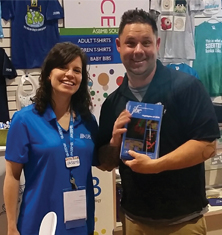 Jenna Dean (left), director of marketing, poses with Jamie
Jenna Dean (left), director of marketing, poses with JamieAtkins of Arata Expositions Inc.
at the ASBMB booth. Atkins sets
up the booth and helps the staff
with myriad tasks at the annual
meeting. courtesy of ALLIson frick
The Federation of American Societies for Experimental Biology serves as the contractor for the convention hall, blocks of hotel rooms, registration and vendors, while Geiling and her team work to figure out who will be coming from the ASBMB and what everyone’s role will be. “Joan’s the one who makes the meeting happen,” Raben said.
A series of deadlines keeps the process moving, beginning with the website launch and open registration. This is followed by the abstract-submission deadline. “That gives us a heads-up as to interest and how many people to expect,” Geiling said.
Attendance varies by city. This year’s choice of Chicago was popular, attracting about 3,600 ASBMB members, Geiling said. Experimental Biology organizers select sites years in advance, and the choice is largely a function of which cities have meeting facilities large enough to accommodate all the activities of the multiple societies. The total attendance for EB is usually 12,000 to 14,000, and some attractive options, such as San Antonio and Baltimore, just don’t have facilities that are big enough. Past meetings have been held in Boston, San Francisco and Washington, D.C. San Diego is the site every other year, and 2019’s meeting will be in Orlando.
Once all the abstracts are in, the next step is assigning posters and talks. Planning the meeting program is like reviewing grants, Raben said. “You learn about things you wouldn’t look at otherwise. You get exposed to new ideas and approaches. That’s the fun part.” He compared the process to the old days of finding interesting research while leafing through the contents of printed journals. “With online journals, you just search for a topic; you don’t happen on things.” As meetings chair, “you’re almost forced to see what’s being presented … The annual meeting is an opportunity to look across disciplines and learn things you’ve never been aware of. It gives you new ideas to think about.”
Then comes the deadline for travel awards. With more than $275,000 in travel grants, the ASBMB helps students and undergraduate faculty fund their trips to the meeting.
All the various applications and submissions are reviewed by committees. “We make sure the people responsible for program content have the information they need and that we keep them on task,” Geiling said.
Funneling all this information requires patience, organization and good tools. “Excel has been a really good friend of mine,” King said, adding that she uses the program to create grids, tables and spreadsheets to keep track of what’s happening where and when. “We need to make sure nothing is conflicting and we have the right size room.” With four other societies sharing facilities in 2018, “we don’t really have a choice all the time.”
For example, committee organizers plan the content for Postdoctoral Development Day. They might need four rooms for presentations and a room for lunch as well as signs to direct participants. Geiling’s job is to have everything organized “so the people running the session can show up, pop in their thumb drive or plug in their laptop, and off they go.”
Flexibility is key, Geiling said, and so is organization. Much of their advance work is responding to emails about deadlines, details and notification: When will I hear about my abstract? When will I be reimbursed for travel? What size is the poster board? What size is the PowerPoint screen? How do I get to the convention center? Students who are going to their first meeting want help. Invited speakers sometimes need assistance with last-minute arrangements.
Showtime
When the meeting starts, the work and the energy ramp up. About half the ASBMB staff attends each year, and everyone is pressed into service. Staffers are at the meeting to interact and raise awareness of their department and committee’s programming, but that’s not all. “We have them multitask,” Geiling said. “They work at our booth or in the meeting office. We have them get lunch because we can’t go out.” Tasks include folding T-shirts, crowd control, registration, pinning up poster board numbers and handing out programs. “Everybody pitches in,” she said. “You just pitch in and make it happen.”
Geiling is on call 24/7 and doesn’t get much sleep, but it’s not all drudgery. “I love being onsite at the events,” she said. “There’s a supercharged energy. People are excited to be there.”
“I love working with people,” King said. “It’s rewarding when you get onsite. It’s not just a job. The members are appreciative.”
The two said they get emails and hand-written cards thanking them for their work. Members seek them out at the meeting year after year. “That’s really nice,” Geiling said.
And the ASBMB has a secret weapon in the person of Jamie Atkins, an employee of Arata Expositions Inc. who has worked with the society since 2006. His official job is setting up the booth, but Atkins always goes above and beyond the call of duty.
“Jamie’s a lifesaver,” King said.
He shows up early and “always seems to arrive when you need help,” Geiling said. He makes sure signs are in the right place, finds misplaced boxes, fetches lunch, folds shirts. When the ASBMB booth offered temporary tattoos one year, the booth was swamped. Atkins jumped in and started applying the tattoos.
“We request him,” Geiling said. “This is his job. He knows the right people, the in-house operations in each city. He’s a make-it-happen kind of person. He gets along well with everyone and he makes friends everywhere … We feed him cookies to keep him going.”
Even with more than a year of planning and all this people power, not all aspects of the meeting can be controlled. When a fire alarm went off at the San Diego convention center in 2012, the building security staff forced everyone to evacuate, King recalled. In 2010, when eruptions of Eyjafjallajökull in Iceland spewed a huge volcanic ash cloud that canceled thousands of airline flights across Europe, multiple speakers were delayed. Although the committee and staff encourage organizers to arrange for backup speakers so any absences can be filled seamlessly, in this case, they were left scrambling.
In the wake of the 2013 Boston Marathon bombing, ASBMB meeting organizers found themselves in a city on virtual lockdown as authorities hunted for the suspected terrorists just days before the annual meeting was scheduled to start. Flights were held and warning signs flashed over highways. “We didn’t know if people could get in,” Geiling said. “It was an unprecedented situation. Representatives from the six EB societies met regularly with convention hall staff to evaluate information and options. The meeting opened on schedule Friday evening about the same time Dzhokhar Tsarnaev was found and arrested in nearby Watertown, Mass.
At the meeting, “people were emotionally impacted by the events,” Geiling said. Some wore Boston Strong hats and T-shirts. “They felt very connected with the city and the people.”
Two years later, again in Boston, meeting planners faced a completely different problem when a longshoremen’s strike in Long Beach, California, interrupted international shipping — including the delivery from China of some 12,000 EB meeting bags. Fortunately, the societies had advance notice. The ASBMB put in an emergency order with a local vendor for bags that were shipped directly to the convention center in time to be distributed at the society’s booth.
Perennial challenges include speakers who cancel at the last minute and complaints about balance in the program. “We always make some people happy and some people unhappy,” Raben said, and that’s where being part of a bigger meeting comes in handy. “We work with EB to make sure every (topic) is covered. I don’t have to worry about getting every discipline in the schedule every time.”
And sometimes a glitch is also a selling point. A number of members enjoyed sharing space with Wolverine and his ilk this year, Geiling said. “Some people asked, ‘Can we always meet with Comic Con?’”
Enjoy reading ASBMB Today?
Become a member to receive the print edition four times a year and the digital edition monthly.
Learn moreFeatured jobs
from the ASBMB career center
Get the latest from ASBMB Today
Enter your email address, and we’ll send you a weekly email with recent articles, interviews and more.
Latest in Careers
Careers highlights or most popular articles
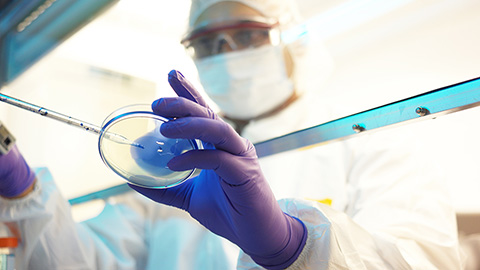
Inside industry postdocs
As more Ph.D. scientists look beyond academia, industry postdocs offer a new kind of training, where mentorship meets mission-driven research. Fellows at Pfizer and Genentech share how these programs prepare them to translate discovery into impact.

Upcoming opportunities
The Lipid Research Division Seminar Series returns Oct. 15 with talks on recent advances in triglyceride cycling in adipocytes.

Writing with AI turns chaos into clarity
Associate professor shares how generative AI, used as a creative whiteboard, helps scientists refine ideas, structure complexity and sharpen clarity — transforming the messy process of discovery into compelling science writing.

Upcoming opportunities
Register for the free ASBMB webinar on the power of "Yes" and knowing when to use it, coming up on Sept. 30!
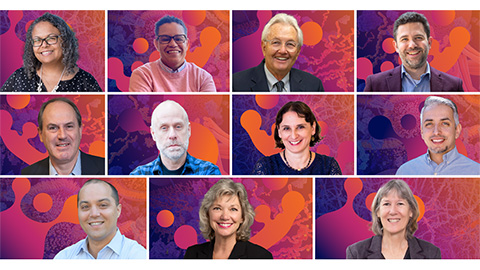
ASBMB names 2026 award winners
Check out their lectures at the annual meeting in March in the Washington, D.C., metro area.

Upcoming opportunities
Register for the free ASBMB Breakthroughs webinar on lipid metabolism, coming up on Sept. 17!

